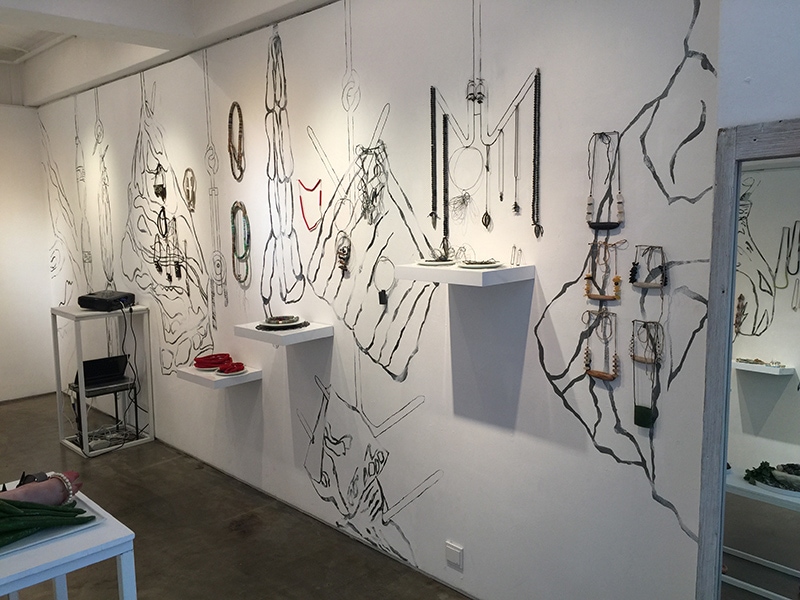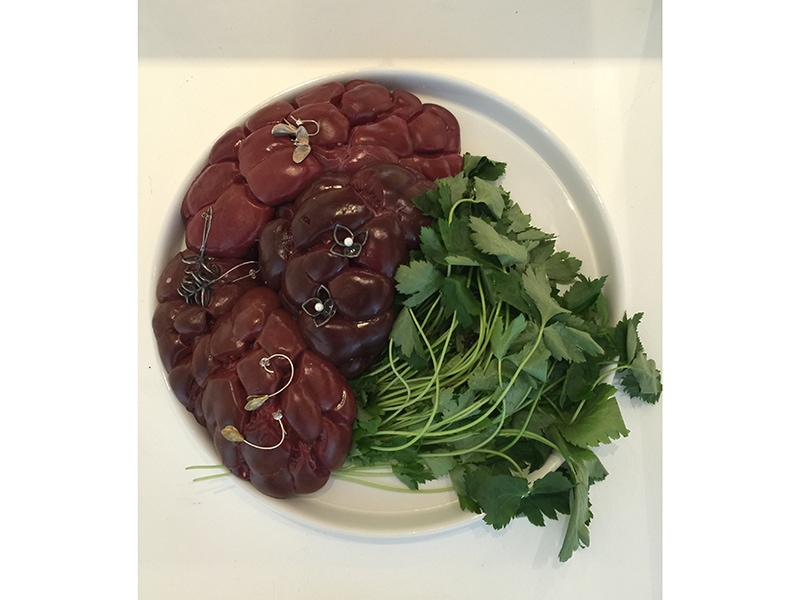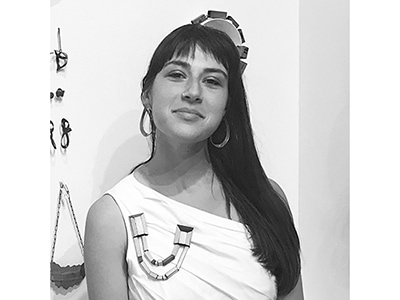Yun Gee Park Gallery, in Tucson, AZ, marries the unique qualities of the Sonoran Desert with a Korean approach that emphasizes the ways art can enhance and elevate a person’s life and actions. The arts-centered destination includes a gallery and gardens complex. A visit there will stimulate all five senses. Scott and Yun talk about their curatorial approach, some of the artists they represent, and exhibitions they’ve organized.
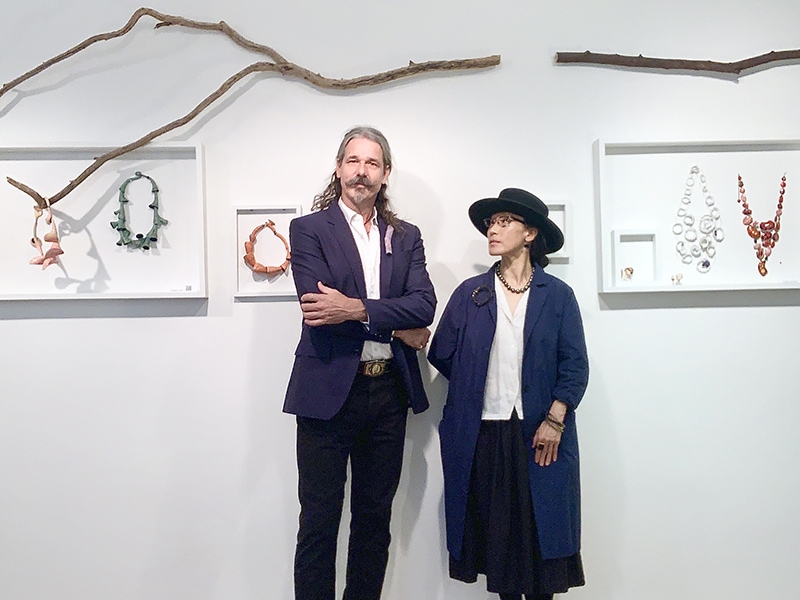
Chava Krivchenia: Your team consists of Yun Gee Park and Scott Duerstock. Tell us about your background before opening the gallery. How did you come to art jewelry?
Yun: We met about 35 years ago in Chicago while we both worked at art galleries there. That time formed the base of our business knowledge of the art world. I had just finished my BFA at RISD. Scott had just finished his bachelor’s degree at Purdue in advertising/PR/visual arts. I was assisting with exhibition curation and client care. Scott, not surprisingly, handled advertising/PR, photography, and events management responsibilities. Today, in our gallery, that is still loosely how we split our primary duties, though we work as a team on almost every aspect of the gallery business.
Scott: After Chicago, Yun and I attended graduate school (Yun for art, and me for cultural anthropology). We married and started raising our children. My first job after graduate school took us to South Korea. I taught and also worked as an administrator for a university in Seoul. It was there that I had my first real exposure to art jewelry, beyond Yun’s personal collection, primarily through the Noh sisters and their Gallery Ahwon. The idea of creating works of art that are portable, consider the environment of the body, are not only still but also in motion, while also conveying the artist’s concept remained fascinating to me even as I pursued my decades-long career in educational administration. When we decided to open our own gallery, the artists we first invited to join us were almost exclusively in the world of art jewelry.
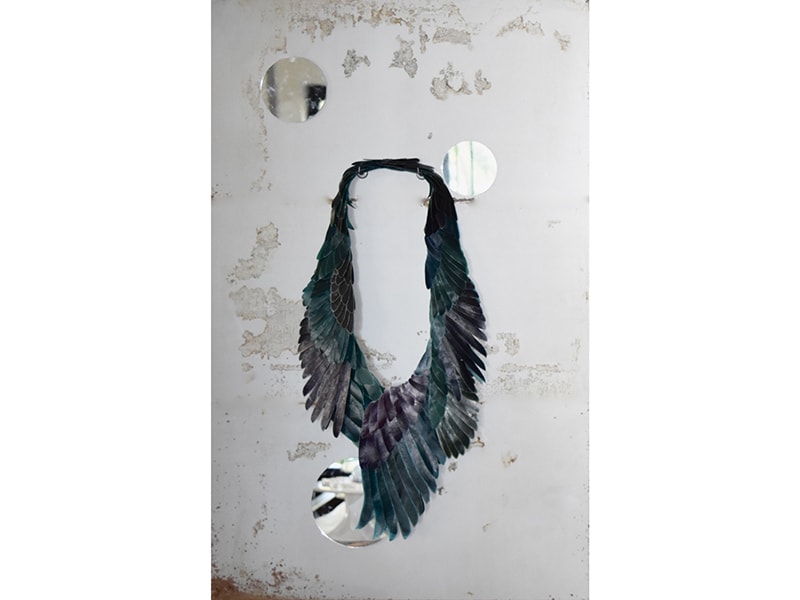
Yun: My fascination with jewelry and wearable art started at a very young age growing up in Korea. My mother always had a collection of fine jewelry. Her jewelry played a very important role for me because of the stories she shared with me growing up. She was from the North. When the war broke out, she and her family barely made it to the South alive.
At that time precious metals and stones were the currency that they were able to carry with them. They had to leave their home, land, and property behind, but jewelry saved their lives. Much was their mother’s jewelry, but traditionally Korean children are usually given gold rings and such when they turn 100 days old. All of the children could help by carrying small amounts of jewelry hidden in their clothing. This gave a small measure of protection if they somehow got separated from the family. Along the way this jewelry kept the family alive. When they finally reached the South, it helped them establish a new life.
My mother never lost that lesson. When she began making money, she started building her collection. My mother is quite beautiful and fashionable, with a fantastic taste for choosing and commissioning jewelry designs. In the back of her mind, though, the value of the materials was always a consideration.
I, on the other hand, had very different tastes in design and collecting! When I went off to RISD to study, I started collecting pieces that I found compelling. The perceived value of the materials wasn’t as important to me as were the concept and design. At first my mother thought my choices were somewhat peculiar and immature. But as she grew older, her appreciation and respect for art jewelry grew. Conversely, so did my appreciation and respect for fine jewelry design, especially with respect to contemporary fine jewelry design and unconventional uses of traditional materials. That is why at our gallery we exhibit and sell art jewelry/wearable sculpture and contemporary fine jewelry.

Scott: In a way, Korea was an incubator for both of us for art jewelry. Perhaps that’s why we have always been so drawn to the works of Korean art jewelers. We are so lucky to represent so many of them who are some of the most admired in the genre of art jewelry.
Tell us about the way you approach curation as appealing to all the senses, with a philosophy that focuses on synthesizing environment, body, and action.
Scott: When we decided to open our own gallery, we wanted to create something different—an arts-centered destination that fully embraced the unique qualities of the Tucson region, but that was also international in scope. This way, both visitors to the region as well as Arizona residents could draw enjoyment and inspiration.
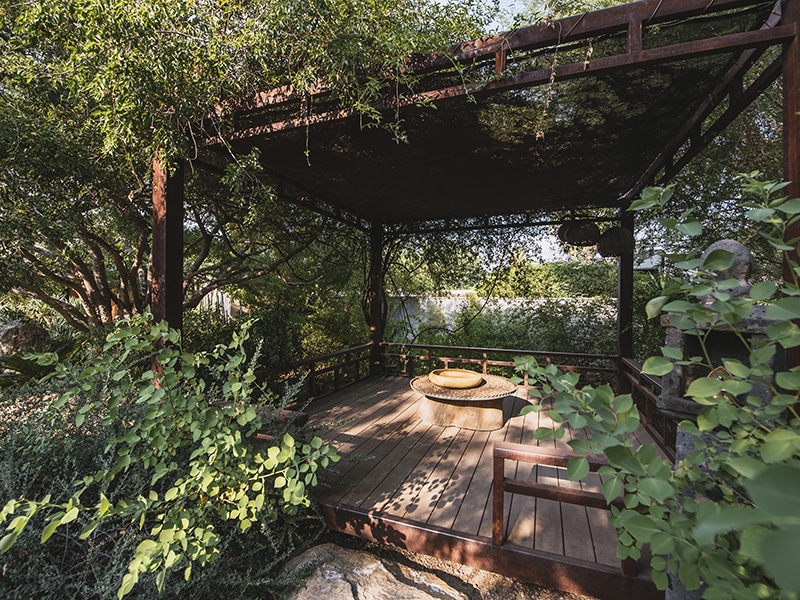
So we created a gallery and gardens complex. On the grounds are the Korean-Sonoran garden, with a gazebo and koi pond; the Mexican-Sonoran meditation garden, called the Jardin de los Santos, with its grotto; and the gallery garden, which is a contemporary Sonoran-themed garden with a sculpture garden adjacent. Interspersed are multiple pavilions, outdoor sculptures, art installations, and even a viewing tower for gazing down at the sculpture garden and out at the mountains. We have plans to create several more private gathering areas around the grounds, and to convert the aviary into a larger group gathering area, too.
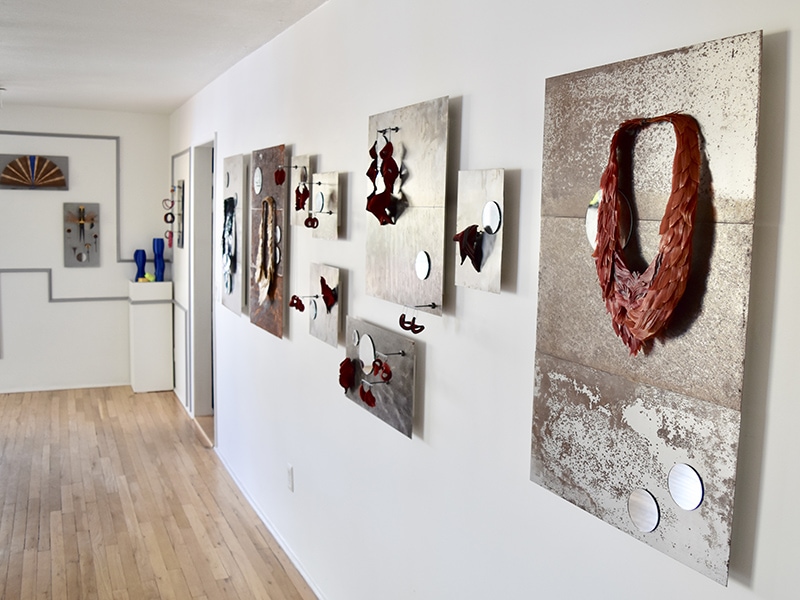
Yun: Rather than a big, white box space showcasing art removed from environment, we wanted to create an environment that showcases living with art. We wanted to emphasize how art can elevate one’s life and actions. This concept is very Korean and very Zen. Importance is given to the moment and to experiencing the moment to the fullest. A tea ceremony is a good example. While sharing tea served in paper cups can be joyful and might well be the best choice for a certain situation, in most cases, well-considered choices of vessels and utensils and their arrangement can significantly elevate the experience and even impart further meaning to the ritual. The same is true for serving a meal, arranging a living environment, or assembling oneself for the day.
Scott: That’s why we present art in categories of curation: curation of body, curation of environment, and curation of action. We want to encourage our patrons to enhance all aspects of their lives in order to meaningfully elevate their environments and activities to the level of art, and to create a meaningful human-to-human connection between themselves and the artists.
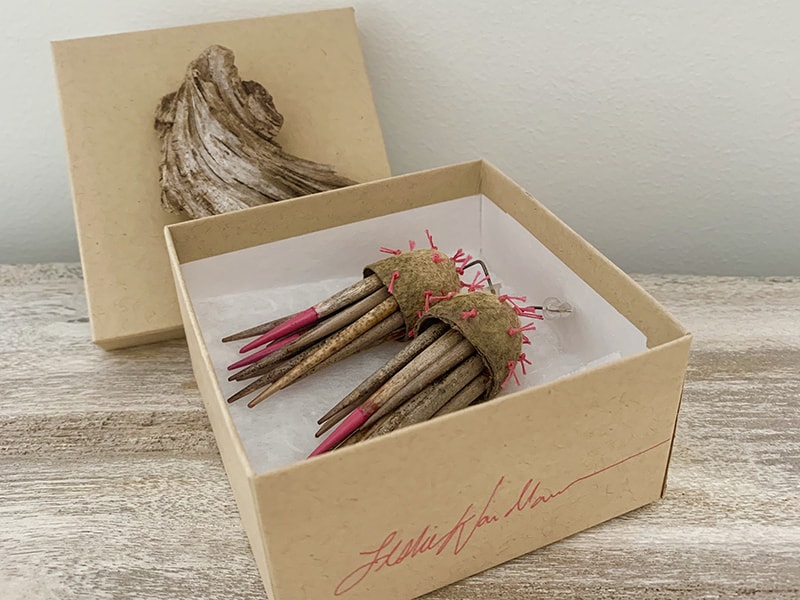
Yun: Also, part of appreciating the moment entirely is being aware of all of the senses. That’s why we strive to make each visit to the gallery a five-senses experience by doing such things as burning Korean incense inside the gallery in the morning and serving tea and Korean snacks. Sound is ever-changing from the birds in the gardens and the laughter and conversation. And the artwork and the settings we create for them provide constant stimulation for the sight and touch.
Scott: To keep the experience fresh, both for ourselves and our visitors, we constantly strive to reimagine the gallery and the manner of presentation of the artworks. We treat the entirety of the galleries and gardens as sort of a three-dimensional, five-senses design “magazine,” the purpose of which is to stimulate the senses. This is in diametrical opposition to the overly pervasive digital-based experiences that tend to dominate our current age.
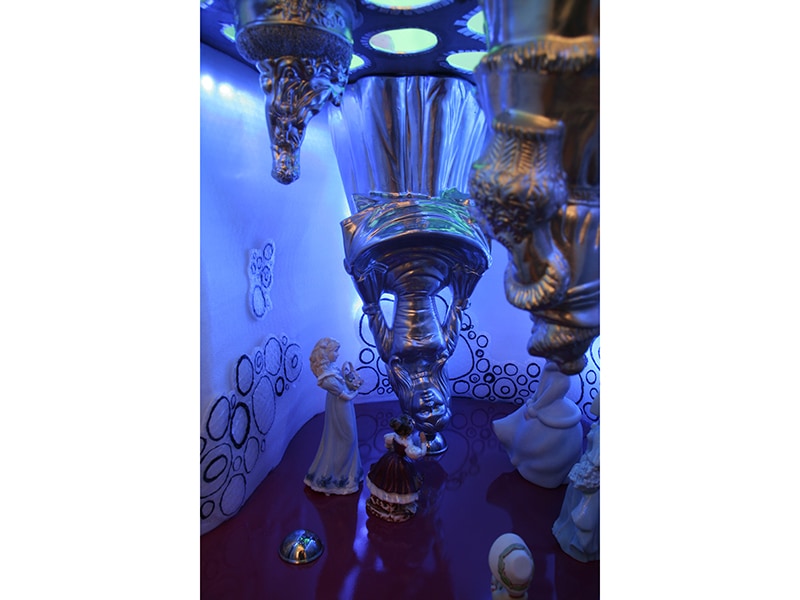
The gallery contains an experimental cabinet of curiosities. Tell us about it. How did you come up with the idea? What do you show in it?
Scott: Since we are a contemporary gallery, we want to allow our artists to explore and expand their concepts in a multitude of ways. The Closet of Curiosities provides an interesting setting to explore installation. The closet is hidden behind a full-length mirror visible as one enters the gallery from the garden. In “normal” [nonpandemic] years, we usually host installations by two artists each year.
Yun: It is a defined space in terms of size, which forces the artist to create the work within the parameters of that space. These limitations, however, create infinite possibilities for novel solutions in expressing their concepts.
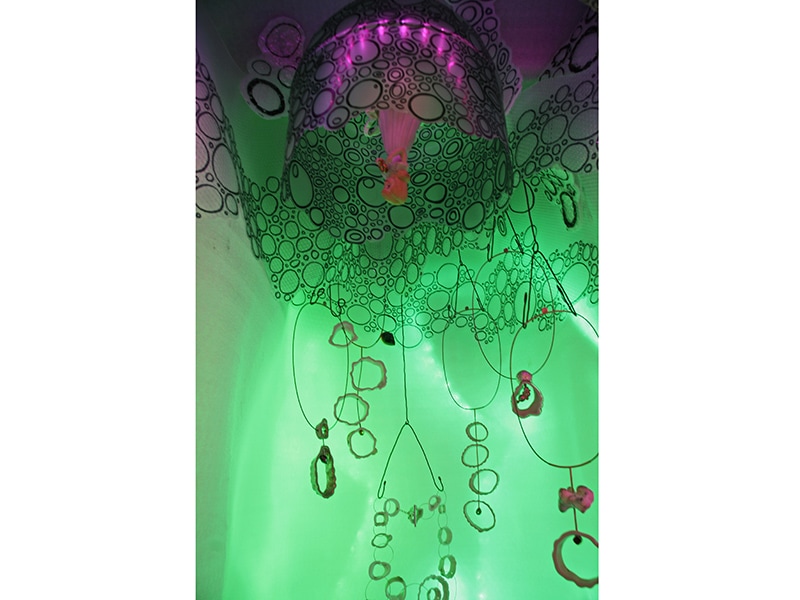
Scott: Art jewelers have done a particularly good job of dealing with these parameters of space. They are adept at creating works that consider the landscape of the human form, and I think that skill translates to other physical settings as they create conceptual environments for their pieces in the closet.

You’re particularly excited about representing the jewelry artist Yves Amu Klein. Tell us more about him and his work. And tell us about other jewelry artists who are exclusive to your gallery, among them Leslie Wardlaw and Cindy Sumner.
Yun: The three artists you mentioned all happen to be Arizona-based. In the case of Yves, he splits his time between Arizona and France. All three are devoted to expanding the vocabulary of art jewelry by exploring new materials and forms, but they came to art jewelry from different starting points and through distinctive paths.
Scott: Yves Amu came to the field from earlier explorations in sculpture. He grew up in a family of artists. His mother, Rotraut, and his uncle, Gunther Uecker, were both sculptors. His father was the French artist Yves Klein. His earlier interests, however, were in time- and motion-based sculpture, and the technical experience he gained from those works influences his jewelry design and creation.
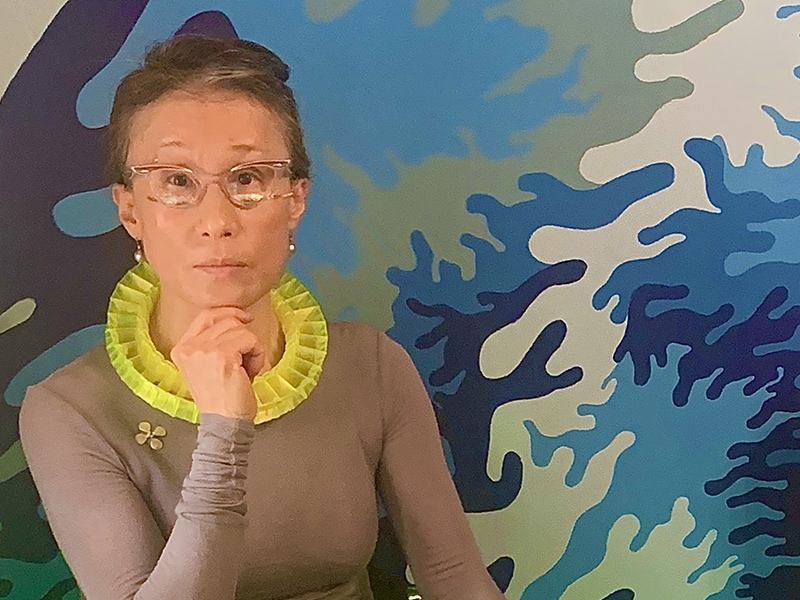
Yves creates his works primarily through 3-D printing using tools that he builds himself. The artist Jim Dine believes that tools provide a link with our past, the human past, and the hand. Yves’s tools are more an extension of the mind and future, where the hand of the artist to the artwork is subordinate to the imagination. Yves’s forms often seem to allude to 16th-century European ruffles, but with clean, contemporary lines. Its color palette, often translucent neon, comes from his material choice of PLA fibers. He often also creates pieces made of links of laser-cut wood pieces integrated into polymers in such a manner that the man-made and natural become equally and mutually dependent on each other for the design and structure of the piece.
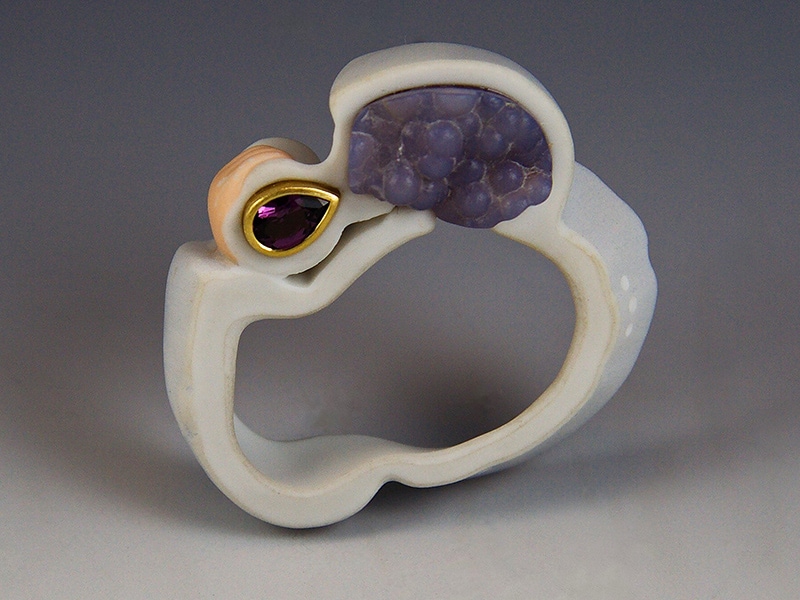
Cindy Sumner, in contrast, comes from a formal goldsmithing and arts background. She deftly combines them both, creating stunningly beautiful forms from her ongoing explorations of nontraditional materials. Quite notable is her Dissections series. In it, ceramic Hummel and Precious Moments figurines are slabbed into cross section, becoming the framework for pieces that yield unpredictable organic forms suggestive of both bone and cell. A wonderful playfulness pervades her work. In this series, the edges sometimes reveal the original figurine form through a sliver of a hand or face—a nod to the parent material and the body it adorns.
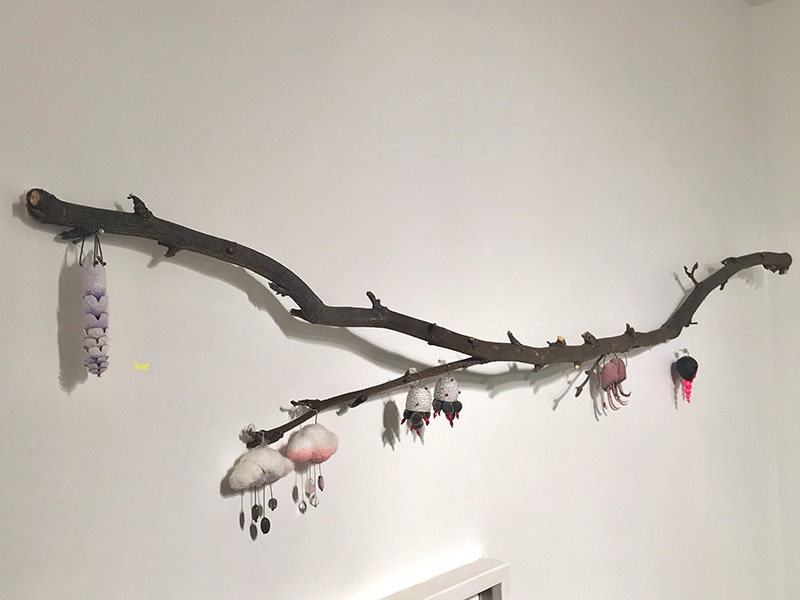
Leslie Wardlaw focuses her work in art jewelry almost exclusively on earrings. Through this form and a variety of natural and man-made materials, she explores wide-ranging concepts and personal experiences such as protection, unconventional beauty, the environment of the West, and even Japanese pearl divers. Her work seeks to broaden the traditional notion of the earring as a predictable and uniform adornment. Her earrings are usually bold and visually stunning. Yet she has a deep understanding of her medium and the wearer, which makes her pieces effortless to wear.
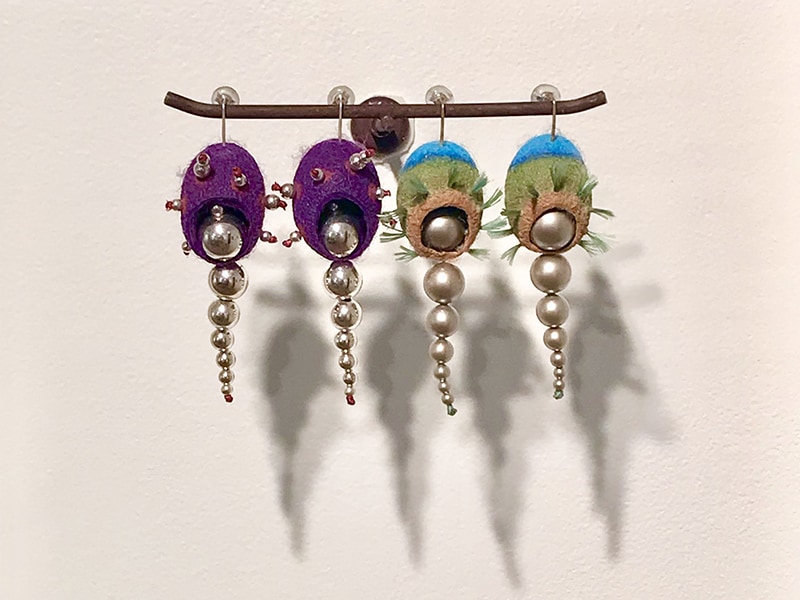
You have exhibited in Korea and Germany. Please tell us about that.
Scott: The pandemic has changed so much about how people travel and reside in our area of the country. But historically Tucson has a significant population of residents who arrive in the fall from other areas of the country to avoid the colder winters elsewhere, and who leave in the spring before the hot summers here in the Southwest begin.
After the final seasonal residents leave in the spring, the art scene slows down significantly. So we then usually travel and conduct shows with our friends at “sister galleries.” It takes a lot of planning and has logistical challenges, but it’s completely worth the effort. We’re able to spend time with amazing gallerists while also exposing our artists to new audiences. It also perhaps allows those who follow our artists digitally to actually experience their work in-person. Social media is great, but nothing compares to seeing a wonderful piece of work up close and admiring the skill and experience of the artists firsthand.
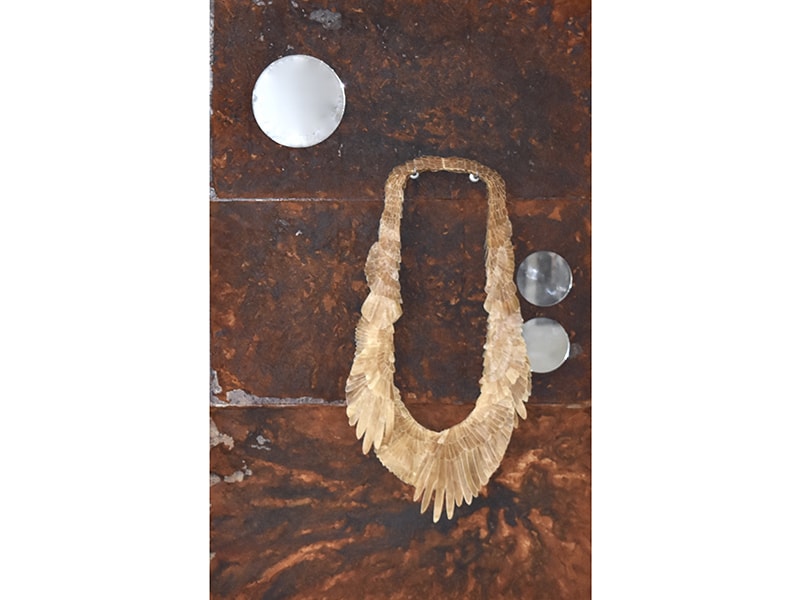
Yun: Beyond dynamic design and interesting concept, an intense attention to technique is one of the most important aspects we look for when inviting an artist to join our gallery. I truly admire and am in awe of the level of craftspersonship of the artists in our gallery. For me growing up in Korea, this attention to technique is of paramount importance. In Korea some craftspeople and artists are designated as national treasures because of the focus, experience, and skill that they have in their chosen field. Actually, sometimes it seems that the knowledge of techniques and materials runs so deep that it appears they may have learned it while still in the womb!
When we travel and do shows abroad, we also get to meet new artists and visit their studios to see their work firsthand. It’s a good opportunity to see if their work is up to our expectations and also to see if our personalities are suited for working together.
Scott: The pandemic has, of course, affected our ability to exhibit abroad. Before the pandemic we were invited to present another exhibition in Seoul, but it has unfortunately been postponed twice. We look forward to getting the chance to present abroad again.
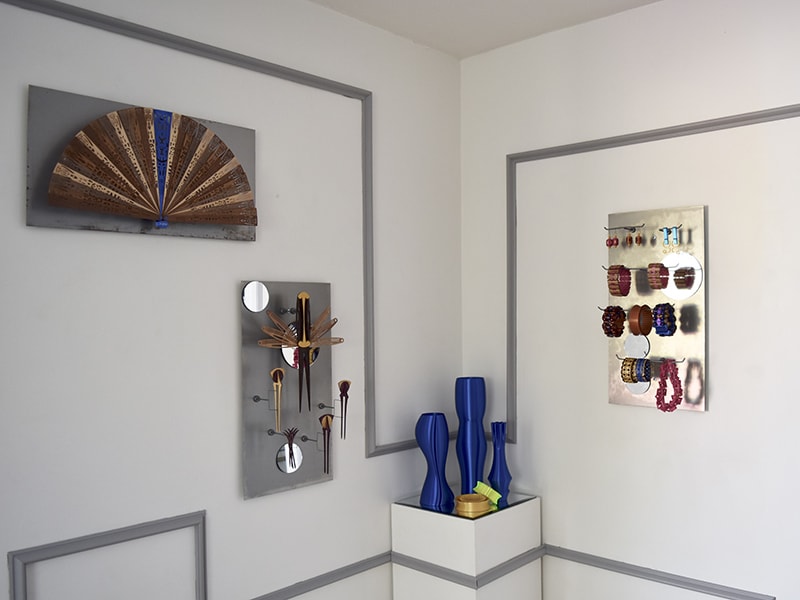
You’ve organized some jewelry exhibitions with fascinating, ambitious concepts. Please describe Different Tastes.
Yun: This was one of the more memorable shows that we put on outside of our gallery. We exhibited it in Seoul and Busan in 2016. It introduced art jewelry by artists from the United States and Europe who had not exhibited before in Korea. They were unknown to most of the people who attended the exhibition.
The title and theme of the show were meant to avoid a valuative judgement of the pieces in comparison to the materials and designs of the jewelry offered there at that time. We wanted to convey an idea of open exploration of the differing aesthetics of the pieces we were exhibiting. To do that, we decided to offer the pieces for viewing upon dishes, as if being prepared for a feast. Another reason we chose this theme is Korea was experiencing somewhat of a renaissance of fusion cuisine. Food has always been an important part of the cultural identity of the country. Many young Korean chefs were returning home from all parts of the world. They were combining recipes and flavors learned abroad with traditional flavors and dishes from Korea.
Abundant magazine articles and television shows featured new dishes and different dishes, and Koreans were willing and ready to try them. While we were not offering a fusion of Korean and European design, we were offering new materials and new ways to think about jewelry. Many of the pieces were displayed on raw meats and vegetables. While shocking, it was meant to convey the idea that it was up to the viewer to complete the dishes. How would they prepare the pieces in their own style? Could they take this different flavor of materials and design and somehow make it their own?
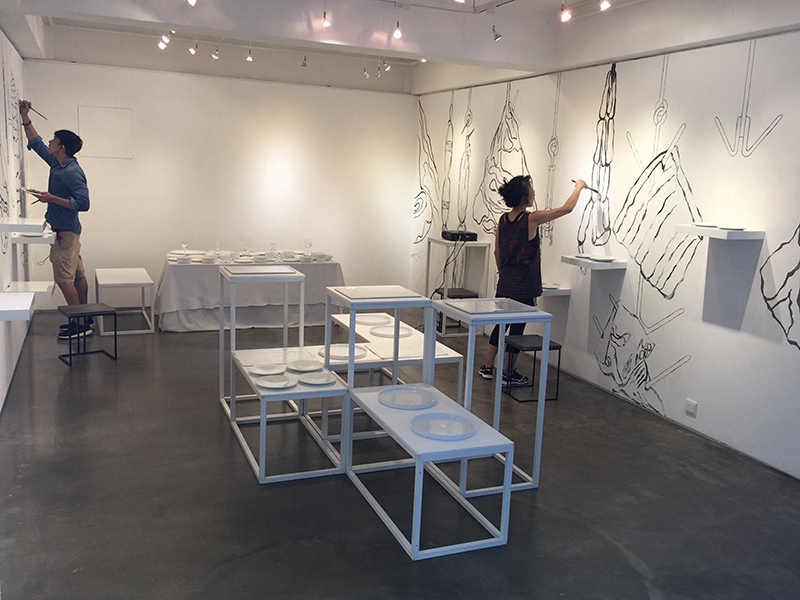
Scott: In Seoul, the show was hosted by Gallery Ahwon. The space was ideal for the concept, but many preparations were needed to make it so. To begin, we painted the perimeter walls of the exhibition like a meat locker. We added a butcher character at the entrance welcoming viewers to join the feast preparation in process. Jewelry was hung on the walls on painted images of hanging beef, sausages, and hams. In the middle of the exhibition, viewers were guided around pedestals with plates of raw vegetables and meats atop. It was quite the adventure gathering all of the materials, like a pig’s leg, and a cow’s heart, liver, and kidney. There was a bit of logistics involved as it was a two-week special rush order to get those ingredients. There was also some question whether it could even be done the way we requested, because we wanted them prepared in ways that were not as market-ready as usual. It all worked out, and we have the images to prove it!
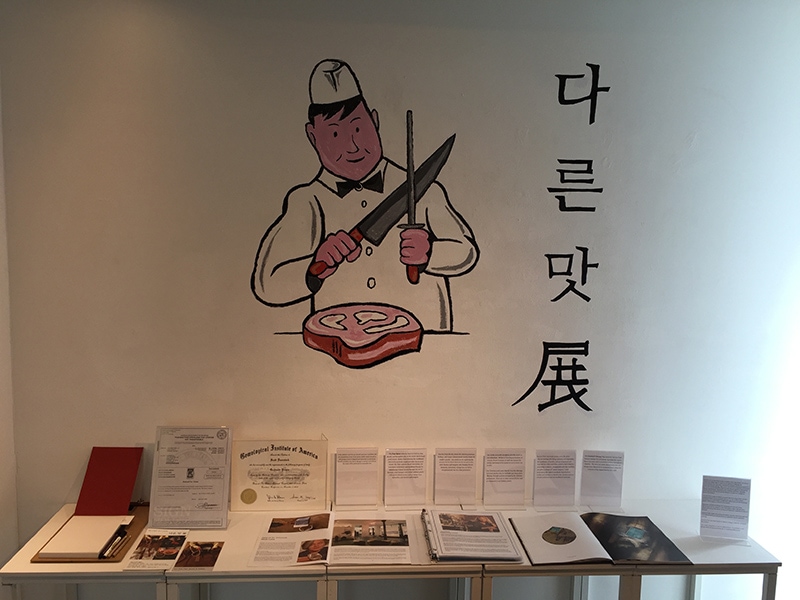
Yun: Onions were interspersed throughout the exhibition, not to scare off vampires, as one viewer jokingly asked, but to symbolize the idea that new recipes could come from shared ingredients. Just as onions serve as a base ingredient in the recipes of many cultures, so it is with silver, gold, and gems, which serve as the base “ingredient” of jewelry designs in many cultural traditions.
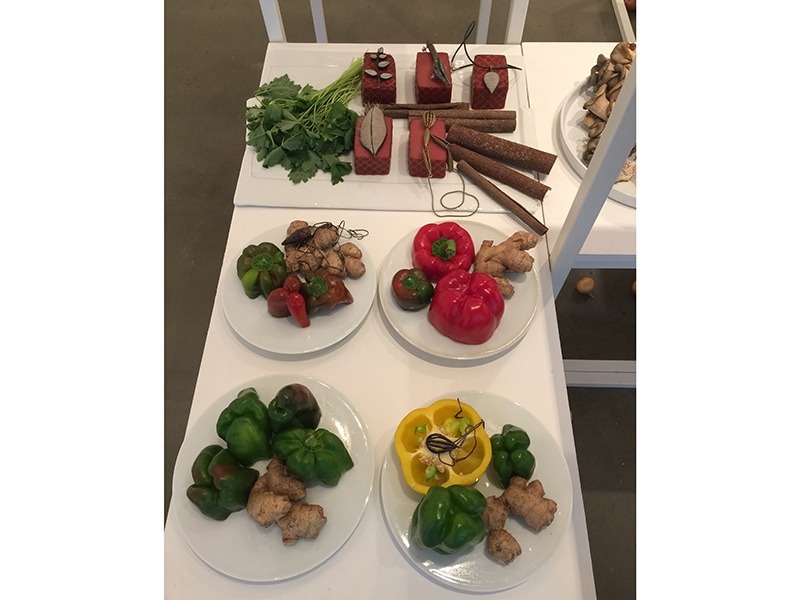
Scott: In the background, on the wall behind the desserts table where jewelry pieces were place atop pastries and cakes, we ran a video loop of works by the artists in the show worn by models and models on the runway.

Yun: The exhibition changed slightly each day. It was the middle of July in Seoul. This is a very hot and humid time just before the annual monsoon rains. The air conditioning struggled to keep up. Because of this, and the fact that the show ran 8–10 hours a day, by the third day or so we decided to remove many of the raw elements. As the show continued, most of the pieces were simply displayed on plates. My onions, however, stayed until the very end!
The show was such a success. It was attended by so many people that it was extended for three days past the closing date. Some of the attendees were visitors to Seoul from Busan, the second-largest city in Korea. As news spread there about the show, another gallery, Merciel Bis, invited us to present the show there, too.
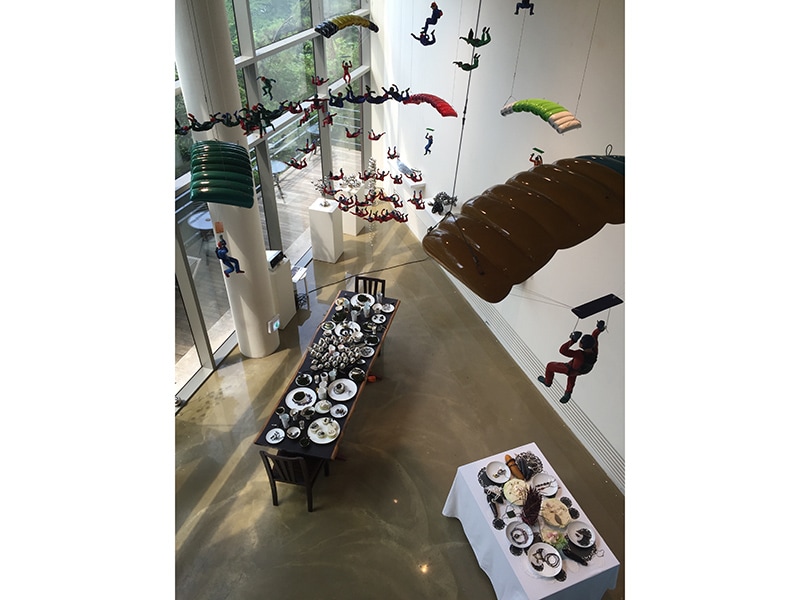
Scott: The main elements of the exhibition stayed the same for each incarnation, but varied slightly based on the location and physical structure of the gallery. For instance, in Busan, which is on the coast, we used seafood rather than beef and pork. This seemed more appropriate to the ingredients we felt were fundamental to recipes in that region of the country.
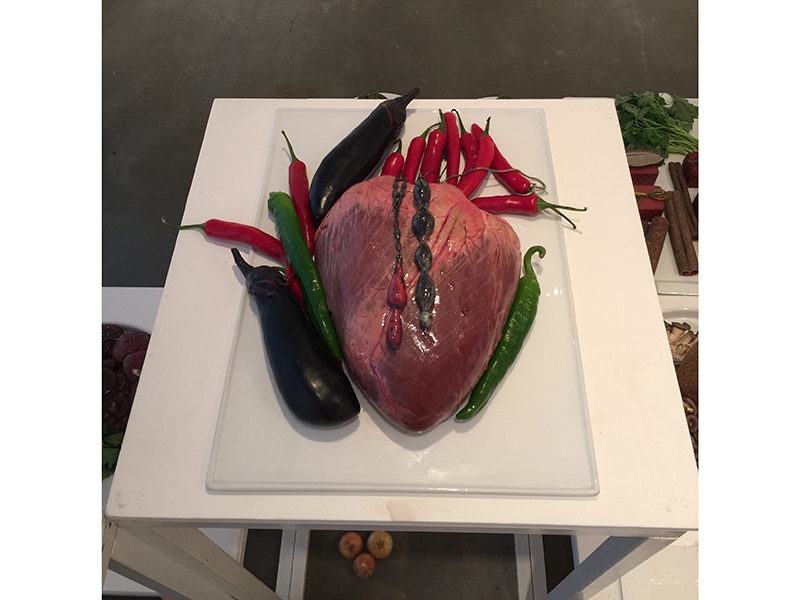
Also, the exhibition was split into two adjoining galleries, so we decided to use a smaller adjacent gallery as the “desserts” table, and also to incorporate some of the art jewelry into fine art pieces that were already on display when we arrived. That, however, is one of the hallmarks of our philosophy on art and curation. At our gallery we see no dissonance in exhibiting what many consider fine or high art with that which some might consider functional art or high craft. For us it a false distinction in most cases. When one considers the inspiration and concept of a piece by Eunmi Chun or Hee Joo Kim, for instance, the moniker of wearable sculpture seems more than apt.
Yun: We look forward to continuing to present exhibitions like this and even beyond, and perhaps to once again present Different Tastes in a different part of the world.

Tucson’s gem show is very well known and well attended. Do you participate in it at all, perhaps on the periphery?
Scott: We feel very fortunate to be located in Tucson with these shows in town twice a year. The main show, of course, is in late January/early February. It is really the place to see some of the best in the world that the gem and lapidary community has to offer. We don’t participate in any of the shows as a gallery, but they do afford us the chance to see some of our artists, who come into town to find materials for their works, and to catch up with other friends in the jewelry business from around the world.

Yun: In the years prior to COVID-19 we used to host a “Gem Show Lounge” event at the gallery, featuring one contemporary fine jewelry artist each year. We even held a fashion show one year. Even though the show is in February, Tucson has very gentle winters. This lets artists and dealers from around the world come after the shows close for the day to experience the works of all our artists while also enjoying a drink and food in our gallery’s gardens. Perhaps we will re-initiate that in coming years.



